Documents: Go to download!
- User Manual - (English)
- Quick Start Guide - (English)
- Getting to Know Your TV
- Completing The First-Time Setup
- Using the On-Screen Menu 3
- SmartCast TV™
- Playing USB Media
- Troubleshooting
Table of contents
User manual Television
Getting to Know Your TV
FRONT PANEL
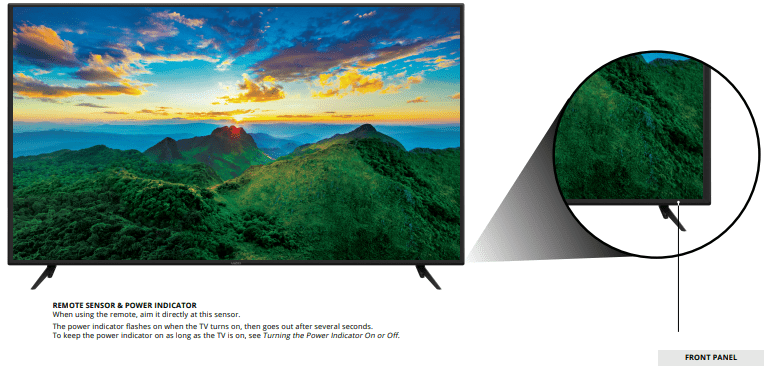
REAR PANEL
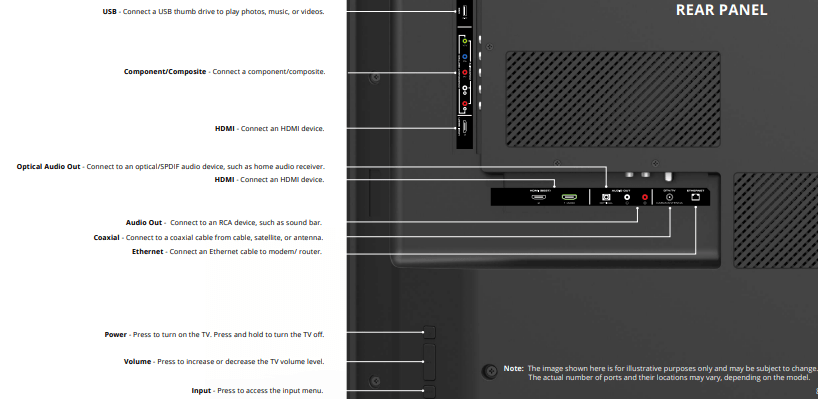
WALL-MOUNTING THE TV
To mount your TV on a wall, you will need a wall mount. Consult the information on this page to find the appropriate mount for your TV.
Be sure the mount you choose is capable of supporting the weight of the TV. After you have determined that you have the correct mount for your TV, you can begin the installation.
To install your TV on a wall:
- Disconnect any cables connected to your TV.
- Place the TV face-down on a clean, flat, stable surface. Be sure the surface is clear of debris that can scratch or damage the TV.
- Remove the stands by loosening and removing the screws.
- Attach your TV and wall mount to the wall, carefully following the instructions that came with your mount. Use only with a UL-listed wall mount bracket rated for the weight/load of this TV.
 Installing a TV on a wall requires lifting. To prevent injury or damage to the TV, ask someone to help you.
Installing a TV on a wall requires lifting. To prevent injury or damage to the TV, ask someone to help you.
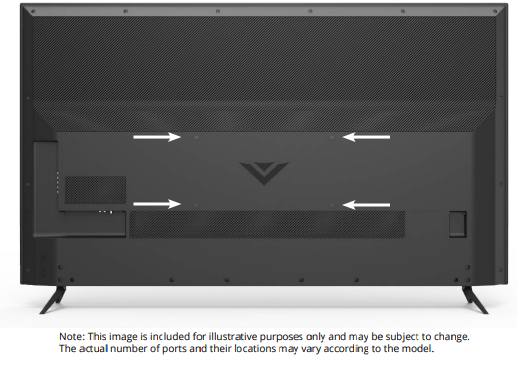

USING THE REMOTE

1. Input - Change the currently displayed input
2. Power - Turn Television on or off
3. App Launcher - Quickly launch the pictured app
4. Exit - Close the on-screen menu
5. Menu - Display the settings menu
6. Arrow - Navigate the on-screen menus
7. OK/Play/Pause - Select the highlighted menu option and play or pause content
8. Back - Go to the previous on-screen menu
9. Info - Display the info window
10. Volume Up/Down - Increase or decrease the loudness of the audio
11. Closed Caption - Open the closed caption menu
12. V Button - Launch SmartCast TV/Return to SmartCast TV Home Screen
13. Pic - Cycle through the different picture setting modes
14. Channel Up/Down- Change the channel
15. Mute - Turn the audio on or off
16. Last - Return to the channel last viewed
17. Number Pad - Manually enter a channel
18. Wide - Change the Television mode
19. Dash - Use with number pad to manually enter a digital sub-channel (For example, 18-4 or 18-5.)
Completing The First-Time Setup
The first time you turn on the TV, the on-screen instructions will guide you through each of the steps necessary to get your TV ready for use:
Before you begin the first-time setup:
- Your Television should be installed and the power cord should be connected to an electrical outlet.
- If you have a wireless network, have the network password ready.
- If you are connecting to your network with an Ethernet cable, connect it to the Ethernet port on the Television.
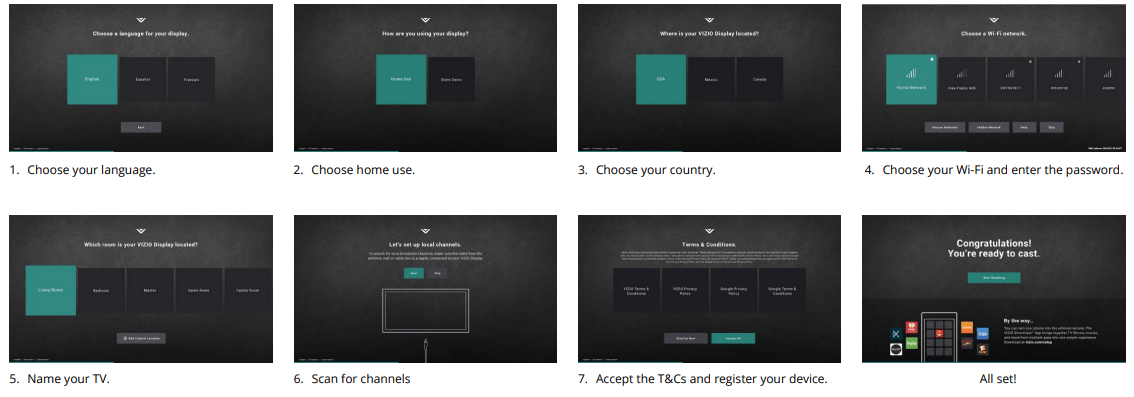
Using the On-Screen Menu 3
Your TV features an easy-to-use on-screen menu.
To open the on-screen menu, press the Menu button on the remote.
From this menu, you can:
- Adjust the Picture settings
- Adjust the Audio settings
- Adjust the Network settings
- Set up the Timers
- Adjust the Channel settings
- Set up Closed Captioning
- Name and adjust Inputs
- Adjust TV settings
- View user manual
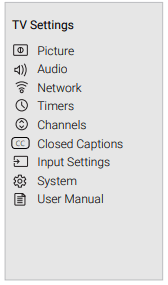
NAVIGATING THE ON-SCREEN MENU
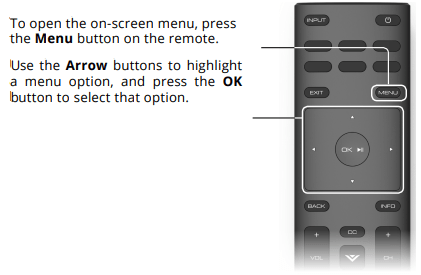
 While navigating the on-screen menu, you can press the Back button at any time to return to the previous menu screen. The Exit button will close the onscreen menu.
While navigating the on-screen menu, you can press the Back button at any time to return to the previous menu screen. The Exit button will close the onscreen menu.
CHANGING THE INPUT SOURCE
External devices such as DVD players, Blu-ray Players, and video game consoles can be connected to your TV. To use one of these devices with your TV, you must first change the input source using the Input menu.
To change the input sources:
- Press the Input button on the remote. The Input menu is displayed.
- Use the Right/Left Arrow buttons or the Input button on the remote to highlight the input you wish to view and press OK. The selected input is displayed.
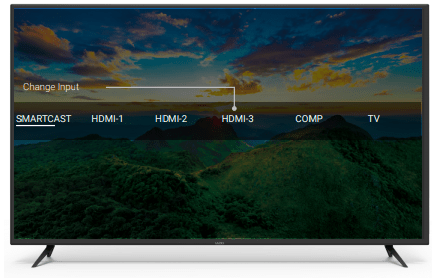
 You can change the input names that appear on the Input menu to make your devices easy to recognize. See Renaming Devices on the Input Menu for more information.
You can change the input names that appear on the Input menu to make your devices easy to recognize. See Renaming Devices on the Input Menu for more information.
CHANGING THE SCREEN ASPECT RATIO
The TV can display images in four different modes: Normal, Panoramic, Wide, and Zoom. Each mode displays the picture differently.
Some programs have black bars on the top or sides of the picture so that the picture keeps its original shape. Examples include wide-screen movies and older television programs.
To change the screen aspect ratio:
1. Press the Wide button on the remote.
2. Use the Arrow buttons to highlight the aspect ratio you wish to view and press OK .
- Normal preserves the content’s original aspect ratio and size.
- Panoramic stretches a 4:3 aspect ratio picture to the left and right edges of the screen. The center of the image is not stretched, but the sides of the image are extremely stretched. If you are watching widescreen (1.85:1 or 2.35:1) content with black bars on the top and bottom, the black bars will still appear on the top and bottom of the display image.
- Wide stretches a 4:3 aspect ratio picture to the edges of the screen. Since the picture is being stretched, the display image may appear distorted—figures appear short and fat. If the program is already formatted for widescreen viewing (1.85:1 or 2.35:1), then black bars will appear on the top and bottom of the display image.
- Zoom expands images evenly in all directions (33% taller and 33% wider) with black bars to fit the screen. A 720p image will fill a 1080p screen.
 Tip: The aspect ratio cannot be changed for Ultra HD content or HDR content.
Tip: The aspect ratio cannot be changed for Ultra HD content or HDR content.
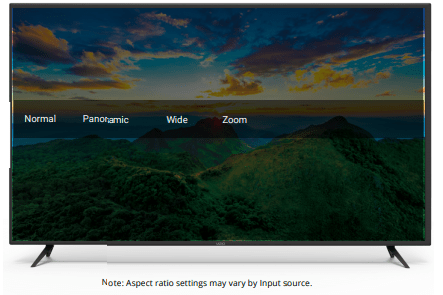
ADJUSTING THE PICTURE SETTINGS
Your TV can be adjusted to suit your preferences and viewing conditions.
 If you’ve made changes to the settings for a picture mode, an asterisk appears after its name (see Saving a Custom Picture Mode).
If you’ve made changes to the settings for a picture mode, an asterisk appears after its name (see Saving a Custom Picture Mode).
To adjust the picture settings:
1. Press the Menu button on the remote. The on-screen menu is displayed.
2. Use the Arrow buttons on the remote to highlight Picture and press OK. The PICTURE menu is displayed.
 If Standard picture mode meets Energy Star® requirements. For the best picture switch to Calibrated mode. Note that Calibrated mode does not meet Energy Star® requirements. Customizing picture setting will change the energy consumption required to operate the TV.
If Standard picture mode meets Energy Star® requirements. For the best picture switch to Calibrated mode. Note that Calibrated mode does not meet Energy Star® requirements. Customizing picture setting will change the energy consumption required to operate the TV.
3. Use the Arrow buttons on the remote to highlight Picture Mode, then use the Left/Right Arrow buttons to change the picture mode:
- Standard mode sets the picture settings to the default settings.
- Calibrated mode sets the picture settings to values ideal for watching TV in a brightly-lit room.
- Calibrated Dark mode sets the picture settings to values ideal for watching TV in a dark room.
- Vivid mode sets the picture settings to values that produce a brighter, more vivid picture.
- Game mode reduces throughput delays and optimizes the picture settings for displaying game console output.
- Computer mode optimizes the picture settings for displaying computer output.
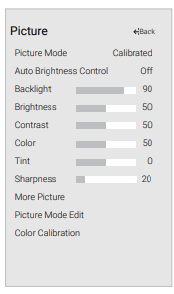
4. To manually change each of the picture settings, use the Up/ Down Arrow buttons on the remote to highlight that picture setting, then use the Left/Right Arrow buttons to adjust the setting:
- Auto Brightness Control - The auto brightness control detects the light levels in the room and automatically adjusts the backlight for the best picture. Select Off, Low, Medium, or High.
- Backlight - Adjusts the LED brightness to affect the overall brilliance of the picture. Backlight cannot be adjusted when starting from some picture modes.
- Brightness - Adjusts the black level of the picture. When this setting is too low, the picture may be too dark to distinguish details. When this setting is too high, the picture may appear faded or washed out.
- Contrast - Adjusts the white level of the picture. When this setting is too low, the picture may appear dark. When this setting is too high, the picture may appear faded or washed out. If the setting is too high or too low, detail may be difficult to distinguish in dark or bright areas of the picture.
- Color - Adjusts the intensity of the picture colors.
- Tint - Adjusts the hue of the picture. This setting is useful in adjusting the flesh tones in the picture. If flesh appears too orange, reduce the level of color before adjusting tint.
- Sharpness - Adjusts the edge sharpness of picture elements. It can be used to sharpen non-HD (high definition) content; however, it will not produce detail that does not otherwise exist.
5. When you have finished adjusting the picture settings, press the Exit button on the remote.
ADJUSTING THE AUDIO SETTINGS
To adjust the audio settings:
1. Press the Menu button on the remote. The on-screen menu is displayed.
2. Use the Arrow buttons on the remote to highlight Audio and press OK. The AUDIO menu is displayed.
3. Use the Arrow buttons to highlight the setting you wish to adjust, then press Left/ Right Arrow buttons to change the setting:
- Speakers - Turns the built-in speakers On or Off.
 When the TV speakers are set to On, DTS signals cannot be passed through digital audio outputs.
When the TV speakers are set to On, DTS signals cannot be passed through digital audio outputs.
- Volume Control Display - Toggle between On or Off to hide or display the on-screen volume slider that appears when volume is adjusted.
- Surround Sound - Surround sound uses DTS TruSurround to deliver an immersive surround sound experience from the TV’s internal speakers. TruSurround completes the entertainment experience by providing deep, rich bass and by delivering crisp details and clear, intelligible dialog. Select On or Off.
- Volume Leveling - Volume leveling uses DTS TruVolume™ to maintain consistent volume levels during transitions between program content, AV formats, and input sources. Select On or Off. In a few cases, volume leveling may artificially suppress volume increases, making it difficult to hear dialog or flattening sudden noises. If this occurs, turn volume leveling off.
- Balance - Adjusts the loudness of the audio output from the left and right speakers.
- Lip Sync - Adjusts the synchronization between the display image and the accompanying audio track.
- Digital Audio Out - Changes the type of processing for digital audio out and HDMI ARC output when connected to a home theater audio system. Select Auto, PCM, Dolby D or Bitstream
- Analog Audio Out - Sets the volume control properties for the RCA connector when connected to a home theater audio system. Select Variable if you are controlling the volume with the TV’s volume controls, or select Fixed if an external audio device (sound bar or AV receiver) will control the volume.
- Equalizer - Adjusts the boost or attenuation of different frequencies using either preset or custom settings. See Changing the Equalizer Settings.
4. When you have finished adjusting the audio settings, press the Exit button on the remote.
ADJUSTING THE NETWORK SETTINGS
Your TV is Internet-ready, featuring both an Ethernet port and built-in high-speed Wireless-Network.
 If your TV is connected to a network with an Ethernat cable, you will not see the wireless network connection menu. You must unplug the Ethernet cable to set a wireless network connection.
If your TV is connected to a network with an Ethernat cable, you will not see the wireless network connection menu. You must unplug the Ethernet cable to set a wireless network connection.
Connecting to a Wireless Network
To connect to a wireless network whose network name (SSID) is being broadcast:
1. Press the Menu button on the remote. The on-screen menu is displayed.
2. Use the Arrow buttons on the remote to highlight Network and press OK. The NETWORK menu is displayed.
3. If you do not see your wireless network displayed, highlight More Access Points and press OK. The WIRELESS ACCESS POINTS menu, which is a list of available wireless networks, is displayed.
4. Highlight the name of your wireless network (this is the network’s SSID) and press OK.
5. Using the on-screeen keyboard, enter your network’s password, then highlight Connect and press OK.
6. Press the Exit button on the remote.
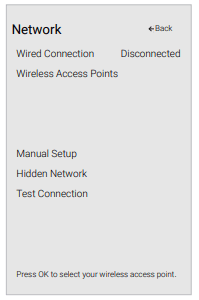
Changing the Manual Setup Settings
Advanced users can fine-tune the network settings using the Manual Setup feature.
To change advanced network settings:
1. From the NETWORK menu, highlight Manual Setup and press OK. The MANUAL SETUP menu is displayed.
2. To change the settings manually, use the Arrow buttons on the remote to highlight DHCP and then use the Left/Right Arrow buttons to change the setting to Off.
3. Use the Arrow and OK buttons to adjust each setting:
• IP Address - The IP address assigned to the TV.
• Subnet Mask - The subnet Exit 2D.
• Default Gateway - Your network’s default gateway address.
• Pref. DNS Server - Your preferred domain name server address.
• Alt. DNS Server - Your alternate domain name server address.
4. Use the Arrow buttons on the remote to highlight Save and press OK.
5. Press the Exit button on the remote.

Finding MAC Addresses for Network Setup
The security settings on your router may require you to enter the TV’s MAC address in the router’s settings.
To find the TV’s MAC address:
1. From the NETWORK menu, highlight Manual Setup and press OK. The MANUAL SETUP menu is displayed.
2. Find the MAC address for the TV at the bottom of the list. The MAC addresses for the connections in use are displayed:
• RJ45 MAC - The Ethernet or RJ45 MAC address may be needed to set up your network when you have connected the TV to your network when you have connected the TV to your network with an Ethernet (Cat 5) cable.
• Wireless MAC - The Wireless (WiFi) MAC address may be needed to connect your TV to your network with WiFi.
SETTING TIMERS
Setting the Timer
When activated, the TV’s timer will turn the TV off after a set period of time.
1. Press the Menu button on the remote. The on-screen menu is displayed.
2. Use the Arrow buttons on the remote to highlight Timers and press OK. The TIMERS menu is displayed.
3. Use the Left/Right Arrow buttons on the remote to highlight the period of time after which you want the TV to go to sleep: 30, 60, 90, 120, or 180 minutes. If you don’t want the sleep timer to activate, change the setting to Off.
4. When you have finished setting the sleep timer, press the Exit button on the remote.

Setting the Auto Power Off Feature
To help save energy, your TV is set by default to turn off after 10 minutes without a video or audio signal. This feature can be deactivated.
To set the Auto Power Off feature:
1. From the TIMERS menu, use the Up/Down Arrow buttons on the remote to highlight Auto Power Off.
2. Use the Left/Right Arrow buttons on the remote to change whether the TV will turn off. If you don’t want the TV to turn off when there is no signal, change the setting to Off. Otherwise, select 10 minutes.
3. When you have finished setting the auto power off time, press the Exit button on the remote.
• Blank Screen - Immediately blank the screen while audio is streaming. This saves energy and LED life.
LISTENING TO ALTERNATE AUDIO
Changing the Analog Audio Language
Some analog over-the-air (free) and cable channels broadcast programs in more than one language. The TV’s Analog Audio feature allows you to listen to audio in an alternate language using Secondary Audio Programming (SAP).
 Not all programs are broadcast in SAP. The Analog Audio Language feature only works when the program being viewed is being broadcast with Secondary Audio Programming.
Not all programs are broadcast in SAP. The Analog Audio Language feature only works when the program being viewed is being broadcast with Secondary Audio Programming.
To use the Analog Audio feature:
1. From the CHANNELS menu, highlight Analog Audio and press OK. The ANALOG AUDIO menu is displayed.
2. Select Stereo, SAP (secondary audio programming), or Mono. Press OK.
3. Press the Exit button on the remote.

To use the Digital Language feature:
1. From the CHANNELS menu, highlight Digital Audio and press OK. The DIGITAL LANGUAGE menu is displayed.
2. Select your preferred language: English, Spanish/Video Description, French. Press OK.
3. Press the Exit button on the remote.

PARENTAL CONTROLS
Using Parental Controls
The TV’s parental controls allow you to prevent the TV from displaying certain channels or programs without a password.
The PARENTAL CONTROLS menu only appears when:
• You are using the tuner to receive your TV signals, such as when you are using an antenna for Over-the-Air signals or when connected to cable TV directly from the wall (no cable box).
• You have a device connected using a composite video cable or a coaxial cable, such as a VCR, satellite or cable box, or DVR.
 Other devices have their own parental control settings.
Other devices have their own parental control settings.
Accessing the Parental Controls Menu
To access the PARENTAL CONTROLS menu:
1. Press the Menu button on the remote. The on-screen menu is displayed.
2. Use the Arrow buttons on the remote to highlight Channels and press OK. The CHANNELS menu is displayed.
3. Use the Arrow buttons on the remote to highlight Parental Controls and press OK.
4. Enter your set System PIN.
 To set a custom parental passcode, see Changing the Parental Control PIN.
To set a custom parental passcode, see Changing the Parental Control PIN.
Enabling or Disabling Program Ratings
To manage program content according to its rating, you must enable the Program Rating feature.
To enable or disable the Program Rating feature:
1. From the PARENTAL CONTROLS menu, highlight Locks and press OK. The LOCKS menu is displayed.
2. Select On or Off and press OK.
Locking and Unlocking Channels
When a channel is locked, it will be inaccessible. Locking a channel is a good way to prevent children from viewing inappropriate material.
To lock or unlock a channel:
1. From the PARENTAL CONTROLS menu, highlight Channel Locks and press OK. The CHANNEL LOCKS menu is displayed.
2. Highlight the channel you want to lock or unlock and press OK.
3. When a channel is locked, the Lock icon appears  locked. The channel is not accessible unless the parental PIN is entered.
locked. The channel is not accessible unless the parental PIN is entered.
4. When a channel is unlocked, the Lock icon appears  unlocked. The channel is accessible.
unlocked. The channel is accessible.
Blocking and Unblocking Content by Rating
A channel may sometimes broadcast programs that are meant for children, and at other times broadcast programs that are meant for mature audiences. You may not want to block the channel completely using a channel lock, but you may wish to block certain programs from being viewed.
When this is the case, you can use the TV’s Rating Block feature to block content based on its rating.
To block or unblock content by its rating:
1. From the PARENTAL CONTROLS menu, highlight the content type you want to adjust and press OK:
USA TV - USA television program broadcasts.
USA Movie - USA movie broadcasts.
Canadian English - Canadian English television program broadcasts.
Canadian French - Canadian French television program broadcasts.
2. For each rating type you want to block or unblock, use the Up/Down and Left/Right Arrow buttons on the remote to highlight the rating type and press OK.
3. When the rating type is blocked, the Lock icon appears  locked. Content with this rating and all higher ratings cannot be viewed.
locked. Content with this rating and all higher ratings cannot be viewed.
4. When the rating type is unblocked, the Lock icon appears  unlocked. Content with this rating and all lower ratings can be viewed. If you want to block all unrated content, highlight Block Unrated Shows and use the Arrow buttons on the remote to select On.
unlocked. Content with this rating and all lower ratings can be viewed. If you want to block all unrated content, highlight Block Unrated Shows and use the Arrow buttons on the remote to select On.
5. When you are finished adjusting the rating level blocks, press the Exit button on the remote.
CHANGING THE TV SETTINGS
Using the SYSTEM menu, you can:
- Check for updates
- View system information
- Change the on-screen menu language
- Set time zone and local settings
- Adjust the CEC settings
- Have the most control over your TV, switch to Quick Start
- Adjust to preserve Aspect Ratio or fill the screen
- Customize TV name
- Review and maintain the list of paired devices
- Adjust accessibility settings
- Reset the TV settings & set up administrative controls.

Viewing System Information
To view technical data and status information about your TV and network connection:
- Press the Menu button on the remote. The on-screen menu is displayed.
- Use the Arrow buttons on the remote to highlight System and press OK. The SYSTEM menu is displayed.
- Highlight System Information and press OK.
- Use the Up/Down Arrow buttons to scroll through the system information.
- When you are finished reviewing the system information, press the Exit button on the remote.
Changing the On-Screen Menu Language
Your TV can display the on-screen menu in different languages.
To change the on-screen menu language:
- Press the Menu button on the remote. The on-screen menu is displayed.
- Use the Arrow buttons on the remote to highlight System and press OK. The SYSTEM menu is displayed.
- Use the Arrow buttons on the remote to highlight Menu Language and press OK. The MENU LANGUAGE menu is displayed.
- Highlight your preferred language (English, Español, or Français) and press OK.
- Press the Exit button on the remote.
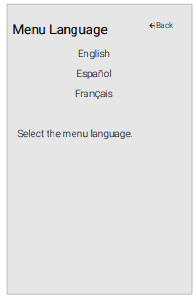
Setting the Time and Local Settings
To ensure the correct time is displayed when you press the Info button, set the TV’s time zone:
- Press the Menu button on the remote. The on-screen menu is displayed.
- Use the Arrow buttons on the remote to highlight System and press OK. The SYSTEM menu is displayed.
- Use the Arrow buttons on the remote to highlight Time & Local Settings and press OK. The menu headed by the local date and time is displayed.
- Highlight Time Zone and press OK. The TIME ZONE menu is displayed.
- Highlight your time zone and press OK.
- Highlight Daylight Saving Time and press OK. The DAYLIGHT SAVING TIME menu is displayed. Choose On if it is currently Daylight Savings Time, Off if it is Standard Time, or Auto to have the system automatically detect Daylight Savings Settings.
- Press the Exit button on the remote.

Adjusting the CEC Settings
The CEC function on your TV enables you to control devices connected to HDMI (ARC) input with the included remote, without any programming. Using CEC, your VIZIO TV remote can control:
- Power On/Off
- Volume
- Mute
 Not all HDMI devices support CEC. See your device’s user manual for details.
Not all HDMI devices support CEC. See your device’s user manual for details.
To enable, disable, or adjust CEC settings:
1. Set up your audio device and connect it to the HDMI-1(HDMI Arc) input on the TV.
2. On your audio device, select the HDMI ARC input.
3. Press the Menu button on the remote. The on-screen menu is displayed.
4. Use the Arrow buttons on the remote to highlight System and press OK. The SYSTEM menu is displayed.
5. Use the Arrow buttons on the remote to highlight CEC and press OK. The CEC menu is displayed.
6. Highligh CEC and press OK. Select a setting and then press OK.
• CEC - To use CEC, you must select Enable.
• Device Discovery - To determain if your device is connected and supports CEC, select Device Discovery and then press OK.
7. Press the Exit button on the remote.
Adjusting the Power Mode
Your Display is set to Eco Mode by default. When the Display is powered off, Eco Mode setting uses less than 0.5W of power. Quick Start Mode enables your Display to power on faster as well as automatically power on when casting content.
 Please note that by changing this setting the energy consumption required to operate this device will change.
Please note that by changing this setting the energy consumption required to operate this device will change.
To switch between Eco Mode and Quick Start Mode:
1. Press the Menu button on the remote. The on-screen menu is displayed.
2. Use the Arrow buttons on the remote to highlight System and press OK. The SYSTEM menu is displayed.
3. Use the Arrow buttons on the remote to highlight Power Mode and press OK. The Power Mode menu is displayed.
4. Highlight either Eco Mode or Quick Start Mode and press OK to select.
Changing the TV Name
Naming your TV helps differentiate it from other cast devices you may have in your home.
To view your TV name:
- Press the Menu button on the remote. The on-screen menu is displayed.
- Use the Arrow buttons on the remote to highlight System and press OK. The SYSTEM menu is displayed.
- Use the Arrow buttons on the remote to highlight TV Name and press OK. The TV Name is displayed.
- Enter your custom name using the on-screen keyboard.
- Press the Exit button on the remote.
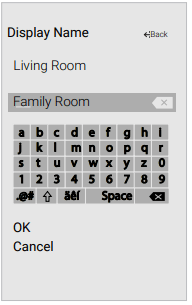
USING THE RESET & ADMIN MENU
You can use the TV’s RESET & ADMIN menu to restore the TV to its factory default settings as well as access other system settings.
Using the RESET & ADMIN, you can:
- Reset the TV to factory settings
- Force the system to power off and on
- Select if LED Power Indicator light is Off or On when TV is
- Create a system PIN code to lock content and picture settings
- Charge devices using the USB port
- Enable or disable anonymous debug data for system performance
- View the VIZIO Privacy Policy
- Start or stop the Store Demo Mode
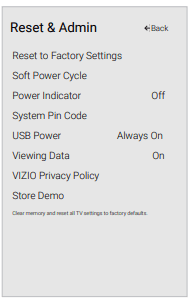
Restoring the TV to Factory Default Settings
All of the on-screen menu settings can be reset to the factory defaults.
 If you restore the TV to the factory default settings, all changes you have made to the settings will be lost! This includes any wireless or picture settings.
If you restore the TV to the factory default settings, all changes you have made to the settings will be lost! This includes any wireless or picture settings.
To restore the TV to its factory default settings:
1. Press the Menu button on the remote. The on-screen menu is displayed.
2. Use the Arrow buttons on the remote to highlight System and press OK. The SYSTEM menu is displayed.
3. Highlight Reset & Admin and press OK. The RESET & ADMIN menu is displayed.
4. Highlight Reset to Factory Defaults and press OK. If you have changed the set system PIN, enter it now. The TV displays, “Select Reset to restore all TV settings to factory defaults and clear all account information.”
5. Highlight Reset and press OK.
6. Wait for the TV to turn off. The TV will turn back on shortly afterward and the Setup App will begin.
Turning the Power Indicator On or Off
The Power Indicator on the front of your TV normally does not glow when the TV is on. You can change this setting if you prefer the light to be on.
To turn the Power Indicator Light On or Off:
- Press the Menu button on the remote. The on-screen menu is displayed.
- Use the Arrow buttons on the remote to highlight System and press OK. The SYSTEM menu is displayed.
- Highlight Power Indicator and press OK.
- Use the Up/Down Arrow buttons to select On or Off, then press OK.
SET SYSTEM PIN
You can set a System Pin to use:
- Picture mode lock
- Parental controls
- Reset to TV to factory default setting
The first time you select System PIN code, you will enter a PIN. The next time you open System PIN code you can reset your PIN code.
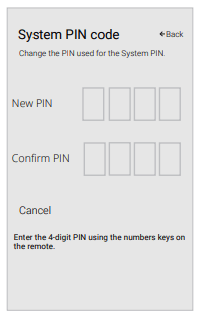
USING THE INFO WINDOW
The Info Window can be displayed by pressing the Info button on the remote:
• Press the Info button one time to display the TV name, current input, picture mode, network name, and time.
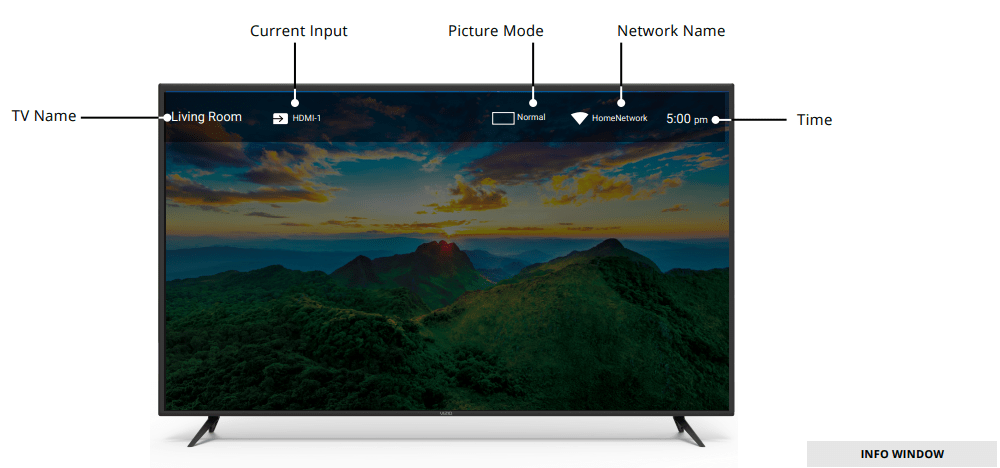
SmartCast TV™
What is SmartCast TV™?
SmartCast TV lets you discover, stream, and control your content like never before. Access top apps like Netflix more easily, using the included remote to browse and launch content directly from the big screen. SmartCast TV makes finding something to watch more fun - discover new shows, including movies in 4K UHD. Plus, you can quickly set up and adjust settings right on the TV using the included remote control.
What can you do with SmartCast TV™?
- Browse and launch top tier apps directly from the big screen using the included remote.
- Stream content directly from the home screen with a single button press.
- Stream high quality entertainment in 4K and HDR10.
- Initiate a stream with the included IR remote, pause with mobile app, continue controlling with voice via Google Home.
How to Launch SmartCast TV™
To launch and begin streaming with SmartCast TV™:
- Press the V-Logo button (
 ) on your remote
) on your remote
-OR-
- Select SmartCast from the list of inputs
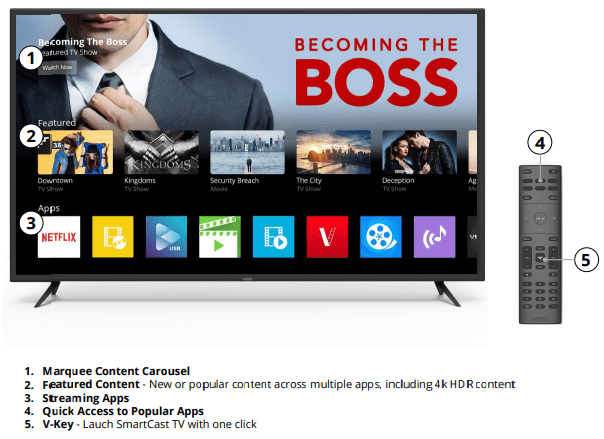
Playing USB Media
Playing USB Media
Connect a USB thumb drive to your TV to play videos.
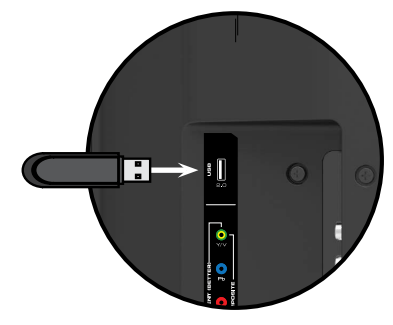
Preparing Your USB Drive to Play USB Media
To display USB media, you must first save your videos onto a USB thumb drive:
- The USB thumb drive must be formatted as FAT32.
a
Files on the USB thumb drive must end in a supported file extension (.mp4). - The player is not designed to play media from external hard drives, MP3 players, cameras, or smartphones.
Displaying USB Media
To display your USB media:
1. Connect your USB thumb drive to the USB port on the side of the TV.
2. The TV will recognize the USB stick. Use the arrow keys on the remote to select the content you’d like to play.
-OR-
Select USB from the bottom streaming icons on the SmartCast Homepage.
 You can display your photos in fullscreen. Select the photo, press OK, then highlight Fullscreen and press OK.
You can display your photos in fullscreen. Select the photo, press OK, then highlight Fullscreen and press OK.
Removing the USB Drive from the TV
To safely remove your USB drive from the TV:
1. Turn off the TV.
2. Disconnect your USB thumb drive from the USB port on the side of the TV.
 Do not remove the USB thumb drive while the TV is on. Doing so may damage the drive.
Do not remove the USB thumb drive while the TV is on. Doing so may damage the drive.
Note: The image shown here is for illustrative purposes only and may be subject to change. The actual number of ports and their locations may vary, depending on the model.
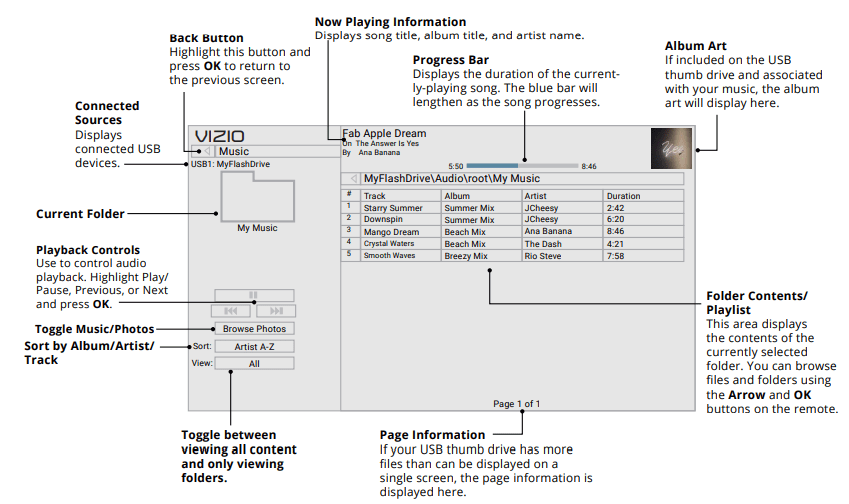
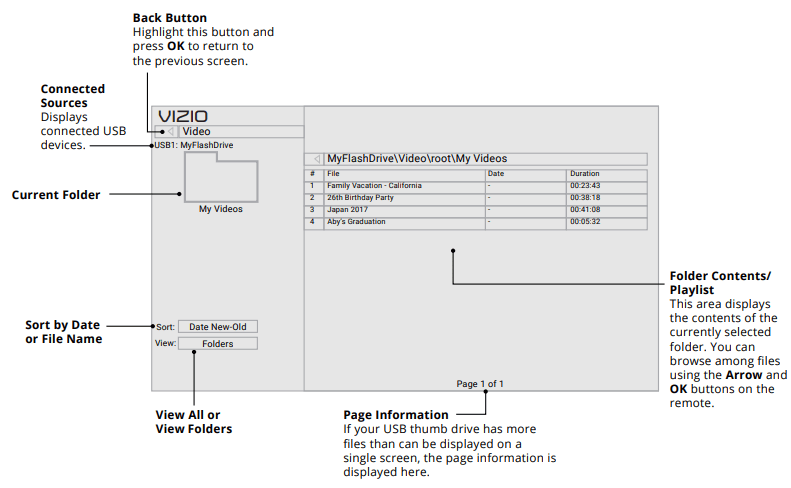
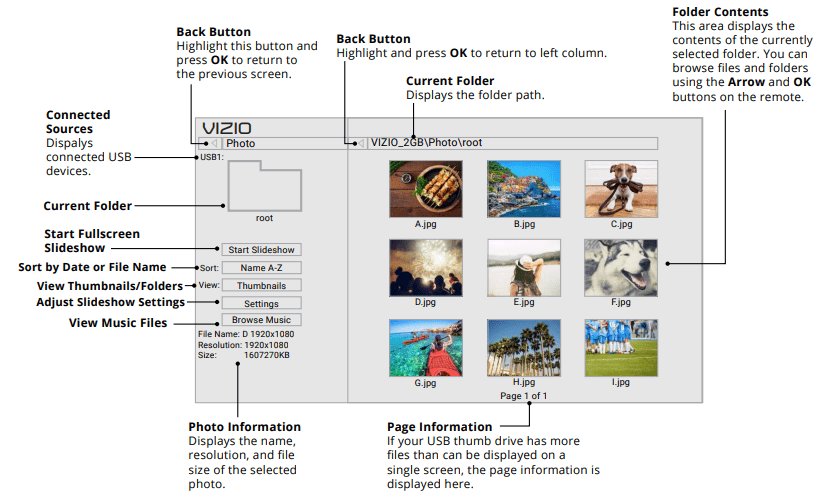
Troubleshooting
HELP TOPICS
The remote is not responding.
- Make sure the batteries are properly inserted matching the - and + symbols.
- Replace the batteries with fresh ones.
The TV displays “No Signal.”
- Press Input button on the remote control to select a different input source.
- If you are using cable TV or antenna connected directly to the TV, scan for channels. See Scanning for Channels.
There is no power.
- Ensure the TV is plugged into a working electrical outlet.
- Ensure the power cable is securely attached to the TV.
- Press the Power/Standby button on the remote or on the back of the TV to turn the TV on.
The power is on, but there is no image on the screen.
- Ensure all cables are securely attached to the TV.
- Ensure all devices are connected correctly. Devices differ; see your device’s user manual for details.
- Adjust Brightness, Contrast, or Backlight. See Adjusting the Picture Settings.
- Press the Input button on the remote to select a different input source.
There is no sound.
- Press Volume Up on the remote control.
- Press the Mute button on the remote to ensure mute is off.
- Check the audio settings. See Adjusting the Audio Settings.
- Check the audio connections of external devices (Blu-ray player, game console, cable/satellite box) that are connected to the TV.
- If you are using an antenna, the signal strength of the channel may be low. Ensure your antenna is connected securely to the TV and move the antenna around the room or close to a window for the best signal.
The sound is flat or dialog is not audible.
- Turn off Volume Leveling. See Adjusting the Audio Settings.
The colors on the TV don’t look right.
- Adjust the Color and Tint settings in the Picture menu. See Adjusting the Picture Settings.
- Select a pre-set picture mode. See Adjusting the Picture Settings. VIZIO recommends selecting Calibrated.
- Check all cables to ensure they are securely attached.
The buttons on the remote aren’t working.
- Ensure you are only pressing one button at a time.
- Point the remote directly at the TV when pressing a button.
- Replace the remote batteries with new ones. See Replacing the Batteries.
The image quality is not good.
- For the best image quality, view high-definition programs using digital sources. Connect your devices with HDMI cables.
- If you are using an antenna, the signal strength of the channel may be low. Ensure your antenna is connected securely to the TV and move the antenna around the room or close to a window for the best signal.
The picture is distorted.
- Move the TV away from electrical appliances, cars, and fluorescent lights.
- Ensure all cables are securely attached.
The TV image does not cover the entire screen.
- If you are using TV, AV, or Component with 480i input, press the
 button on the remote to change the screen mode.
button on the remote to change the screen mode.
The TV has pixels (dots) that are always dark.
- Your HD TV is precision-manufactured using an extremely high level of technology. However, sometimes pixels may not display correctly. These types of occurrences are inherent to this type of product and do not constitute a defective product.
I see “noise” or static on the screen.
- When your TV’s digital capabilities exceed a digital broadcast signal, the signal is up-converted (improved) to match your TV’s display capabilities. This up-converting can sometimes cause irregularities in the image.
- If you are using an antenna, the signal strength of the channel may be low. Ensure your antenna is connected securely to the TV and move the antenna around the room or close to a window for the best signal.
When I change input source, the TV image changes size.
- The TV remembers the viewing mode on each input source. If the viewing mode on the new input source differs from the one on the input source you switch from, the difference may be noticeable.
- See Changing the Screen Aspect Ratio.
How do I download the VIZIO SmartCast™ App?
- Make sure your phone or tablet is connected to a Wi-Fi network. Open a browser on your phone or tablet. Navigate to vizio.com/smartcastapp and follow the on-screen instructions to download the VIZIO SmartCast™ App.
How do I change the Inputs?
- Make sure the VIZIO SmartCast™ App is installed on your phone or tablet. Open the VIZIO SmartCast™ App. Tap on the Device list and select your TV. Tap on the Input key and select the Input of your choice.
- Press the Input button on the back of the Display to cycle through the Inputs.
- Press the Input button on the basic remote to cycle through the Inputs.
How do I connect to my Wi-Fi network?
- On your IR remote, press the Menu button then go to Networkà Select your Wi-Fi nameà Enter password.
- Open the VIZIO SmartCast™ App on your phone or tablet. Tap on the device list and select your Display. Tap on the Settings iconà Network à Wireless Access Points. Select your Wi-Fi network from the list, enter the Wi-Fi password, and tap Connect.
How do I stream apps like Netflix and Youtube to my VIZIO SmartCast™ Display?
- Download and open a Chromecast-enabled apps on your mobile device, such as like Netflix or Youtube. Then tap the Cast button.
How do I exit Demo Mode
- Press and hold the Input button on the back of the Display to exit the demo mode.
How do I watch Cable/Antenna TV channels?
- If you subscribe to cable or satellite, simply connect an HDMI cable (not included) to the receiver.
- If you use external antennas to watch local broadcast channels, a TV tuner is required and is sold separately by third parties.
See other models: E191VA E320-C0E E321VT D43F-F2 D320-B1
